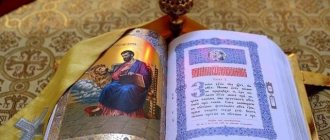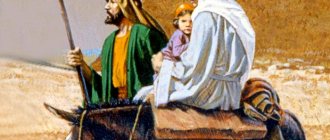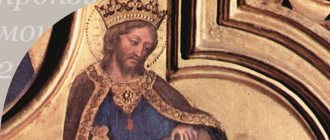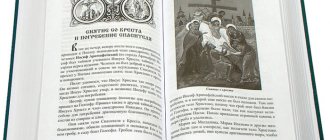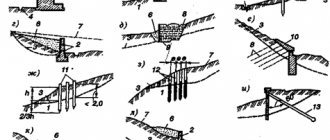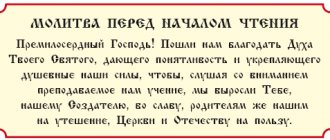Genesis (Old Testament), summary
“Genesis” is a book that tells about the creation of the world, the fall of man, the history of antediluvian civilization, the history of the flood. About halfway through the book, the story switches to the story of one family: Abraham's family. It was the descendants of Abraham who became the ancestors of the entire Jewish people. It was this small people who maintained faith in the true God for centuries, so special attention is paid to their history. The twelve sons of Jacob, Joseph, and the coming of the Hebrews to Egypt are the highlights of the final chapters of Genesis.
Preface
The Old Testament is, first of all, the story of the Creator’s salvation of the fallen human race. The Lord wished that humanity’s ascent to the fullness of the New Testament should occur gradually, as people’s ability to comprehend the Truth increased. Moreover, according to the all-wise Providence, Old Testament history itself, its persons and rituals served as pre-images (prototypes) of New Testament persons and events. And if, on the one hand, according to the word of our Lord Jesus Christ, He came to fulfill
Law (see Matt. 5:17), then, on the other hand, before His coming it was necessary to fulfill the entirety of prophecies and foreshadowings.
So that this fullness may also testify of Christ: O fools and slow of heart to believe all that the prophets have foretold!
Is this not how Christ had to suffer and enter into His glory? (Luke 24:25–26).
The Old Testament contains 50 books - 39 canonical and 11 conditionally non-canonical - different in the author's religious passion and information richness, in the style of presentation and language palette... This circumstance alone complicates the understanding of the history of the relationship between God and man in pre-Christian times for an insufficiently prepared reader. In addition, some books of the Old Testament are oversaturated with everyday details or, on the contrary, require mandatory knowledge of the history of the Jewish people and the peoples inhabiting this huge ancient region. As a rule, this becomes an insurmountable obstacle for the average Orthodox reader.
We make an attempt to publish a Summary of the Old Testament in sayings that, if possible, would bypass numerous geographical and historical details. The task of our publication is to characterize the essence of Old Testament times, to convey the intensity of expectation of the Messiah. the Messiah, who, being the God-man, endured the agony of the cross, so that whoever believes in Him would not perish, but have eternal life
(John 3:15).
At the same time, the Old Testament was and remains a textbook of true wisdom. The fate of ancient Israel contains a great lesson - both for entire nations and for each individual person. But not only the history of God’s chosen people or, say, the Book of the Wisdom of Solomon is capable of edification - the very spirit of Divine Revelation imbues a person with wisdom. We hope the reader will pay attention to this property of the sayings collected in our book.
And, finally, the main task of the Summary is to encourage the reader to a deeper study of this great fact of our life - the Old Testament, about which the Savior Himself said: Until heaven and earth pass, not one jot or one tittle shall pass from the law, until everything will not come true
(Matt. 5:18).
Exodus (Old Testament), summary
The book of Exodus is the second book of the Old Testament. It was written by Moses, like Genesis, and begins the story from the moment when the life of the descendants of Jacob in Egypt became unbearable.
“Exodus” is the story of the flight of the chosen people from Egypt and their search for their land. In the desert, Moses will be given the commandments, the same ten commandments that children still learn in Sunday schools. The stories about the parting of the sea, the manna coming down from heaven, and the golden calf are all from the book of Exodus.
There are 39 books in the Old Testament, and they are all very different. Not all of them are historical or legal, like Genesis or Exodus. There are also poetic works, for example, “Ecclesiastes,” and there are prophetic works, for example, “The Book of the Prophet Isaiah.”
Perhaps the most famous and frequently used book is the Psalter (Old Testament). It is difficult to convey a brief summary of this book, since it all consists of poems. These poems were, of course, not written in Russian, so the rhymes and meter were lost in translation. But all the same, poetic images, a repentant or joyful mood, reasoning about the will of God remained.
In general, the Old Testament is the book of the Jewish people. Christians consider them prophetic; they find in the text many indications that Christ is the Messiah. For them, the essence of the Old Testament is to bring the Jewish people to Christ, to accept Him as Savior. Modern Jews do not agree with this at all. For Jews, the composition and text of these books differs somewhat from the Christian version.
Fendi
is an Italian fashion brand founded
in 1918
. The Fendi brand belongs to the LVMH (Moët Hennessy Louis Vuitton SA) trademark. The specification of the Fendi fashion house is women's clothing and interior elements (sofas and sofas).
The history of the famous Fendi fashion house began in a small Roman leather workshop. In 1925, Eduardo Fendi
(Edoardo Fendi) and
Fendi
opened their first store selling branded products, which were distinguished by high quality and handcrafted finishing.
Very quickly their products began to be in high demand. In 1932,
the couple opened the first fur salon. Thanks to traditionally high quality and elegant styles, Fendi fur coats have become the standard of Italian style.
Five daughters
Eduardo & Adele Fendi, after they retired from business, began to continue their business.
Paola Fendi
was responsible for the fur department,
Anna
Fendi was responsible for creating new collections,
Alda
Fendi was the commercial director,
Carla
Fendi regulated the development strategy of the Fendi Fashion House, and
Franca Fendi
(Franca Fendi) specialized in public relations (PR).
In 1955
Paola and Anna presented their collection of fur and leather for the first time.
The Italian public countered with unanimous recognition of the professional competence of their successors. However, until then the brand was known mainly only in Italy and, in order for it to gain international fame, the sisters invited the famous fashion designer Karl Lagerfeld
. As time shows, this was a historical, strategically correct decision. The Fendi Fashion House gradually became known throughout the world.
Karl Lagerfeld changed the concept of all collections of the House. The main emphasis was placed on their fur and leather products. The once chic bulky fur coats have become elegant and light, enriched with a rich color palette and combinations of different types of fur. The designer constantly introduced various innovative elements that distinguished the products of the Fendi fashion house from others. The creative union with the Fendi family was also successful because Paola Fendi prepared a huge assortment of unusual materials that were created based on the latest achievements of the industry. As a result, Karl could endlessly fantasize, creating various models, which were often based on the unique characteristics of certain materials.
Among other things, since the early 70s
, Karl Lagerfeld began developing a women's line of Pret-a-Porte clothing, as well as a collection of accessories.
And the 80s
were marked by a significant expansion of the activities of the Fendi Fashion House.
Prior to this, the house's products were intended for wealthy people over 30 years old and, in order to attract a new target audience, it was necessary to launch a youth line Fendissimo
.
Almost simultaneously, the Fendi Casa furniture line was presented .
In 1984
The launch of a line of sunglasses, jeans and scarves begins.
In 1985,
the Fendi fashion house introduced a perfume line with the flagship Fendi fragrance.
Five years later, a new fragrance, Fantasia, was released, then in 1996
- Life Essence,
in 1998
- Theorema,
in 2001
- Theorema Uomo and many others.
In 1990
For the first time in its 65-year history, the Fendi fashion house is presenting a line of men's clothing.
In the 90s
The potential of the Fendi fashion house was appreciated by Prada and LVMH, purchasing
51% of the shares from the owners in 1999 However, Prada subsequently lost its stake to LVMH.
At the moment, Karl Lagerfeld remains the designer of the women's clothing line. Silvia Fendi is responsible for the men's line and accessories.
The Fendi fashion house is constantly expanding and currently has more than 100 branded boutiques around the world. Latest (at the beginning of 2008)
was opened in New York on Fifth Avenue. Experts predict rapid growth and significant profits for the company in the future. The main thing is that the Fendi Fashion House never ceases to delight us with new collections that not only fans of the brand, but also new consumers will be happy to buy.
Interesting Facts:
- In 1962, the Fendissime line was created by Karl Lagerfeld and the five Fendi sisters. The line was not a success and is currently out of production;
- Fendi has its own collection of Swiss watches;
- Kanye West showed up to one of the Hollywood parties with the Fendi logo shaved on the back of his head;
- in June 2006, the management of the large hypermarket chain Wal-Mart was accused of selling fake Fendi. Fendi's June 2007 lawsuit against Wal-Mart was dismissed in June 2007, due to the fact that the Wal-mart group of companies agreed to pay Fendi an amount in exchange for dropping the litigation.
Information sources:
- Fendi (brand history);
- Fendi (Wikipedia);
- history of the Fendi brand;
- history of the Fendi brand;
- history of fashion brands - Fendi.
Abstract “The Bible and its structure. The spiritual meaning of the Old and New Testaments."
Content
Introduction
- Origin of the Bible
- Structure of the Bible
- Spiritual meaning of the Old and New Testaments
Conclusion
Introduction
Bible means book in Greek. It is the basis of three world religions: Islam, Christianity and Judaism.
Despite the fact that the Bible is the Holy Scripture for Christianity and Jews, it is also considered a world landmark.
As you know, atheism was widespread on the territory of the Soviet Union, so the distribution and study of the Bible was prohibited. However, since the mid-1980s the ban has been lifted. Today the Bible is the most widely circulated book in the world. It has different interpretations of its name: Book of books, book of salvation, word of God, etc. The Bible consists of the Old and New Testaments. These books differ from each other: Firstly, they were written at different times, and secondly, they were written by different people, with different professions (Moses, Peter, Solomon, Matthew, Paul).
Object of work – the Bible as a whole
Subject of work: contents of the Bible
Purpose of the work: to study the structure of the Bible, the meaning of the Old and New Testaments.
In connection with this goal, the following tasks can be identified:
- Talk about the origins of the Bible
- Reveal the structure of the Bible
- Consider the spiritual meaning of the Old and New Testaments
This work can be used in lessons at schools and at lectures in other educational institutions.
The work consists of an introduction, three parts, a conclusion and a list of references.
1. Origin of the Bible
The Bible was given to people by God himself. One might wonder: did He write it himself? Of course not. The Bible was written over the course of 1600 years by approximately 40 people. God is the author of the book, but He wrote it through a righteous man, that is, God is also the inspirer.
Another question can easily arise: why did God give humanity the Bible? In the texts of the Bible, God reveals to us the “rules” of a worthy and righteous life, those canons that will help a person lead a correct and worldly life. This is how He himself speaks about it: “Do not add to what I command you, and do not subtract from it; keep the commandments of the Lord your God which I command you.”1
The Creator carefully ensured that His thought was accurately presented in the Book. Scientists have found that when studying the Old Testament, God divides the history of the world into three periods.
I
: Adam – Moses.
In this passage of time, we see how God conveys his messages: first Adam was awarded this opportunity, by the way, it was here that God first began to appear to people. In the future, Adam passes on the Knowledge to his descendants. We know a few: Enoch, Methuselah, Noah, Abraham and Moses. The events that happened to these righteous men are mentioned in the books of the Old Testament and the entire Bible.
II
: generations throughout the life of Moses.
These events begin in the book of Exodus. Here is a description of the acts of Moses at the command of God, an interpretation of His laws, and a presentation of what was written to the people.
III
period: Joshua – Malachi.
In this period, God calls upon all His righteous to write down all His words—the laws—for Him. They said that everyone should help each other, regardless of origin. God made sure that his Book reached the next generations and beyond, teaching humanity goodness and truth.
Considering this issue, you can see that God did not force His words to be written down, but through revelation and with the help of the Holy Spirit, and only holy people - righteous people - could receive such an honor.
Let us ask the question: what is the difference between the Orthodox faith and the Protestant faith?
Protestants believe that if a person accepts Jesus Christ as the Most High and Savior, then he immediately becomes saved and holy, and practically no special things need to be done to achieve the desired result. And Orthodox Christians, right after the Apostle James, believe that: “ faith, if it does not have works, is dead in itself”1. And Christ Himself answered: “Not everyone who says to Me: “Lord!” Lord!” will enter the Kingdom of Heaven, but he who does the will of My Father in Heaven.”2
It follows from this that if you read the opinion of Orthodox Christians, if you want to prove your faith in the Lord, then you must observe all those commandments that express His will.
Another distinctive feature of the protostants is that they do not have monasteries or monasteries. There are monks in our Orthodox Church, and they work hard to fulfill all the commandments of Christ.
In addition to this, monks take three vows: celibacy, non-covetousness, obedience to the spiritual leader (as the Apostle Paul did). This path of a monk is more spiritual and righteous than the path of an ordinary layman.
- Structure of the Bible
The Bible is a rather complex book in structure. It consists of independent books. But basically it can be divided into the Old and New Testaments.
Old Testament.
The Old Testament is a part of the Bible that describes events from the creation of the world to the Birth of Jesus Christ (XIII - I century BC). This part describes the events in the life of the Jewish people. From this we can conclude that part of the Bible is common to Christianity and Judaism.
Originally the word "covenant"
came from Moses when the Lord gave him 10 commandments carved on tablets. People had to follow these rules, and the Lord gave them love and mercy - thereby a covenant (agreement) was concluded between people and God.
Structure:
- Torah: Genesis, Exodus, Leviticus, Numbers, Deuteronomy – Moses
- Books of the Prophets
- "Scriptures"
All the events in this book may seem cruel. Large numbers of sacrifices, fratricides, sin - and that’s not all...
Humanity itself has abandoned life in paradise, depriving itself of eternal life, adding illness. But the Lord did not turn away from them. He sends them the righteous in the person of Moses, and with him the commandments by which people must live. And after him the Savior comes to earth, who at the end of his life delivers all the righteous from hell and takes away people’s sins.1
“In the beginning was the word, and the word was with God, and the word was God” - this is how the Old Testament begins its story for us.
New Testament
The New Testament consists of 4 blocks. The first block includes the collection of the Gospels from various apostles, who tell us about the coming of the Son of God to earth. The second block follows the Epistles of the Apostles. The third block is the Epistles of the Apostle Paul. Well, block 4 is the revelations of John the Theologian.
Jesus Christ was born a poor man, but despite this he healed people and gave them faith in the Almighty. However, people did not appreciate this and crucified Him on the cross, calling Him the King of the Jews. The main feature of the New Testament is that despite the fact that people treated Jesus Christ so cruelly, He forgave them their sins. Christ appeared on earth to save humanity from sin, to restore people’s connection with God.
Structure.
The New Testament begins with the four Gospels (Matthew, Mark, Luke, John). The word gospel means good news. Jesus Christ appeared with this good news. His coming gave humanity new hope for a righteous life, that for the sins that a person has committed during his life, one can ask God for forgiveness through prayers and confession
The next block of the New Testament is the Epistles of the Apostles. These apostles were James, Peter, John and Jude. In their messages, the apostles address people, telling them how to live righteously, as Jesus teaches them.
The third component of the New Testament is the Epistle of the Apostle Paul.
His messages are divided into 4 categories:
1. Epistles that were written during the period of evangelistic travel: 1st and 2nd Thessalonians, Romans, 1st and 2nd Corinthians and Galatians.
2. Epistles that were written during his imprisonment in prison: Ephesians, Philistines, Colossians and Philemon.
3. Pastoral Epistles: 1st and 2nd Timothy and Titus.
4. Epistle to the Hebrews.
The very last book of the New Testament is Revelation. It was written by John the Theologian. This book is also often called the book of the Apocalypse. Here John recorded his conversation with God about the future of humanity, about its future fate, and your fate after death depends on how you live.
- Spiritual meaning of the Old and New Testaments
The history of the Old Testament contained the lives and stories of people with their subsequent falls and the selection of God's chosen persons for their further salvation. In this case, by fall we mean people losing faith in God and committing sin, and by salvation I mean their salvation from God’s wrath (for example, Noah). God granted salvation to those people who lived in accordance with His covenants.
There were plenty of such falls in the Old Testament: the loss of paradise, the murder of Abel by Cain. This is just the beginning. After the death of Abel, people try to forget God, replace Him in forging metals or in idleness. However, one important thing plays a role here too - people could not live in harmony with God. The flood occurs, and again there is a chosen one - Noah. And Noah becomes the continuer of the human race. But here, too, everything did not go smoothly - people decided to build the Tower of Babel in order to capture the sky. The punishment is multilingualism and chaos of nations. This time, God chooses not just one person among the chosen ones, but an entire people - the Jews (descendants of Shem).
The most serious picture, in my opinion, is the scene of Abraham and Isaac. Abraham was ready to kill his son at the command of God. And why? Yes, because God was looking for an answer - is He ready to give His Son if humanity gives its own.
Thus, the essence of the Old Testament is the reflections of God - whether humanity is ready or not ready to accept Christ.
New Testament.
The meaning of the New Testament is that humanity is not able to change itself with the help of God's laws. It's vicious. After his death, Jesus Christ took people’s sins upon himself, giving them an incentive for a healthy life, for a life without vices.
His example was supposed to teach that the path to God is thorny and dangerous. That one must follow His teaching to the end, without renouncing Him (which is what Jesus Christ did). Of course, this path will not always be so difficult. But if they meet on a person’s path, it means they were sent by God in order to test faith in Him.
Conclusion
Summing up the results of this work, we can note the following: The Old Testament is a preparation for the coming of the Mission. God tested people, checked whether people were worthy for the Savior to come to them. And He came. However, he was killed. But His death did not mean the end of everything. On the contrary, she opened people’s eyes to many things: to mercy, to virtue, to the path that you must follow in order to achieve the Kingdom of Heaven. And the most important thing is that despite all the difficulties and trials, a person must believe in God, because God sends us trials because He knows that we can cope with them... This is the test of faith.
Today we are awaiting the Second Coming of Christ. However, not all people see this as completely new. We increasingly turn to God only when we need something, and do not thank us when we receive it. Evil, self-interest, and envy are being sown more and more in humanity. And this is how we remember the vices of humanity. And the outcome of the Second Coming of Christ depends on how deeply this all gets stuck in us.
But let's be optimistic, I hope that humanity will still turn away from vices. After all, you can show your love not only through prayers, but through help. This is what Jesus Christ taught us – mercy.
The objectives of the work were completed in full, the task was achieved.
(Deuteronomy 4.2)
(James. 2, 17)
(Matt. 7:21)
[Electronic resource] URL: https://fb.ru/article/157212/zavet—eto-chto-znachit-istoriya-vethogo-zaveta (access date: 04/03/2017)
Time and language of writing
The Old Testament (also called Scripture) was created in the pre-Christian era: XIII-I centuries. BC. It is written in Hebrew and partly in Aramaic. This book is revered as Holy Scripture by Christians and Jews (they call it Tanakh and differ from the editions of the Christian Old Testament).
The New Testament was written at the beginning of our era - starting in the middle. I century - in ancient Greek (or rather Koine: a variant of the Greek language that was formed in the Hellenistic era in the Eastern Mediterranean and became the language of interethnic communication). The New Testament is the holy book of Christians.
Cup of Two Testaments
The majority of parishioners of Orthodox churches know that it is necessary to read the Gospel, and that this must be done constantly, preferably every day.
But as for the Old Testament, priests often hear perplexed questions from parishioners: “Is this also mandatory?” Deacon Vladimir Vasilik, a regular contributor to our magazine, talks about the connection between the two Testaments, their deep unity and the difference between them.
What does the Old Testament mean to us? The word "covenant" (Hebrew "berit") meant "agreement." But the phrase Old Testament has two meanings. Firstly, this is precisely a contract, specifically a contract between God and people. Initially - personal agreements with the ancient patriarchs and righteous people - Noah, Abraham, Isaac and Jacob. God demanded from them faith, devotion only to Him and obedience to His commands. For this, He granted them salvation (as, for example, Noah and his family) and blessing (as, for example, Abraham). This is the personal guidance of God, contained in His commandments, which were transmitted and preserved orally. The sign of the covenant was circumcision.
Then there is a covenant or agreement concluded through Moses at Sinai with the entire people of Israel. It was that God would be the only God of Israel, and Israel would be His people. This agreement is in detailed form and is recorded in writing in the Pentateuch (the first five books of the Old Testament - Genesis, Exodus, Leviticus, Numbers, Deuteronomy; Genesis, however, reflects events before the covenant of Moses). The purpose of the Covenant is to distinguish the people of Israel from among humanity and make them chosen, so that the seeds of true faith can be preserved in them and then spread to all humanity. The Lord Jehovah (Jehovah, or Yahweh) becomes the invisible, spiritual king of the Israeli people, who thus receives a special form of government - theocracy, or government by God. The law implied a special way of life, special, “clean”, so-called kosher, food, and prescribed in detail the ritual of sacrifices and sacred rites.
The second meaning of the phrase “Old Testament” is a collection of sacred books, the first, pre-Christian part of the Bible. There are two canons of the Old Testament - the Protestant, based on the Jewish, and the Orthodox, based on the Alexandrian. The first includes the Pentateuch of Moses (Genesis, Exodus, Leviticus, Numbers, Deuteronomy), historical books - the Book of Joshua, four Books of Kings, two Books of Chronicles (priestly chronicles), two Books of Ezra, the Book of Esther, educational books - Psalms of David, Proverbs Solomon, Ecclesiastes, Song of Songs, Book of Job; great prophets - Isaiah, Jeremiah, Daniel, Ezekiel and twelve small ones - Hosea, Joel, Amos, Jonah, Obadiah, Micah, Nahum, Habakkuk, Haggai, Zephaniah, Zechariah, Malachi. The Orthodox, or Alexandrian, canon also adds to them books that have come down to us only in Greek: the three Books of the Maccabees, the Book of the Wisdom of Solomon, the Book of Judith, the Book of Jesus, son of Sirach. What is the significance of these books and how do they relate to the New Testament?
Let us immediately note that the New Testament cannot be read deeply and correctly without at least a superficial knowledge of the Old Testament. As St. Augustine so wonderfully said, “The Old Testament is hidden in the New. The New is incomprehensible without the Old.” There are 82 references to the Book of Deuteronomy alone in the New Testament. There are many references to the Book of the Prophet Isaiah. The constant refrain of the Gospel of Matthew is that the Scripture may be fulfilled, for example, in the story of the Nativity of Christ: And all this happened, that it might be fulfilled which was spoken by the Lord through the prophet, who says: Behold, the virgin is with child and bears a Son, and they call His name Emmanuel, which means : God is with us (Matthew 1 :22–23). This prophet is Isaiah, who foresaw the birth of Christ from the Virgin (see: Is. 7 , 14). As the holy martyr Justin the Philosopher says, “there were once blessed and righteous people, pleasing to God, who spoke by the Holy Spirit and predicted the future, which is now coming true. They are called prophets. They alone knew and proclaimed the truth to people... they spoke only what they heard and saw when they were filled with the Holy Spirit. Their writings still exist today, and whoever reads them with faith receives much instruction about the beginning and end of things. The very events that have already happened and are now still happening are forced to accept their testimony. Also, for the sake of the miracles that they performed, they deserve faith, because they glorified the Creator of all and proclaimed Christ His Son sent from Him; what the false prophets did not do” (Justin Martyr. Conversation with Tryphon the Jew).
The books of the New Testament are filled with joy because ancient prophecies are being fulfilled, which anticipate all the miracles and deeds of our Lord Jesus Christ - from Christmas to Pentecost, which is also the fulfillment of what the prophet Joel predicted: And it shall come to pass after this that I will pour out my Spirit on all flesh, and your sons and your daughters will prophesy; Your old men will dream dreams, and your young men will see visions. And also on the male and female servants in those days I will pour out My Spirit. And I will show signs in heaven and on earth: blood and fire and pillars of smoke. The sun will turn into darkness and the moon into blood before the great and terrible day of the Lord comes. And it shall come to pass that whoever calls on the name of the Lord will be saved (Joel 2, 28–32).
Understanding the New Testament is unthinkable without the Old Testament books, as well as our church life. Especially without the Psalter, in which, in the words of Blessed Augustine, the Lord Jesus Christ Himself and His Church sing, weep and rejoice. We constantly hear the Psalter during divine services: these are kathismas at Vespers and Matins, and psalms of the hours. Other books of the Old Testament are read at Vespers on the indicated days; these readings are called proverbs. Their reading is especially solemn on Christmas Eve, Epiphany and Holy Saturday, when their number can reach 15.
But what about the Old Testament as the Law?
Often an Orthodox Christian hesitates between two maxims: behold, I am making everything new (Rev. 21 :5) and Do not think that I came to destroy the law or the prophets: I did not come to destroy, but to fulfill (Matt. 5:17 ). And moreover, the Savior says: For truly I say to you, until heaven and earth pass away, not one jot or one tittle will pass from the law until everything is fulfilled (Matthew 5:18 ). But how does Christ fulfill the Law? By deepening and spiritualizing it. If the Law forbade killing, then Christ commands not to be angry: You have heard what was said to the ancients: do not kill; whoever kills will be subject to judgment. But I tell you that everyone who is angry with his brother without cause will be subject to judgment; whoever says to his brother: “raqa” is subject to the Sanhedrin; and whoever says, “You fool,” is subject to fiery hell (Matthew 5 :21–22). If the eighth commandment commands not to commit adultery, then Christ says that anyone who looks at a woman with lust has already committed adultery with her in his heart (Matthew 5:28 ). In other words, if the Law prohibited only external sinful actions, then the Savior goes inside and cuts off the spiritual, psychological roots of sin. Let us note, however, that when speaking about the Law in the Sermon on the Mount, the Savior means primarily the Ten Commandments and does not say a word about ritual or legal regulations. It should be mentioned that even in the Old Testament there was a prophetic tradition according to which a moral law was given at Sinai, not a ritual one. It is present, in particular, in the holy prophet Jeremiah: for I did not speak to your fathers and did not give them a commandment on the day that I brought them out of the land of Egypt about burnt offerings and sacrifices; but he gave them this commandment: “Obey my voice, and I will be your God, and you will be my people, and walk in every way that I command you, that it may go well with you” (Jer. 7 :22-23).
Much was given to Israel by Moses because of the hardness of the hearts of the Israelites, and not because of the goodness of God, therefore the original commandment must be preferred to the subsequent one. When the Pharisees tell Christ that Moses allowed them to divorce, they receive a harsh rebuke: He says to them: Moses, because of your hardness of heart, allowed you to divorce your wives, but at first it was not so; but I say to you: whoever divorces his wife for reasons other than adultery and marries another commits adultery; and he who marries a divorced woman commits adultery (Matt. 19, 8–9).
Let's give another example: the Old Testament law forbade taking interest from one's fellow tribesman, but allowed it to be taken from a pagan. In the New Testament, and then in church law, extortion is prohibited altogether.
So, Christ gives a deeper and more perfect moral law based on grace and love.
The question arises: how to relate to the ritual regulations of the Law - about clean and unclean food, about sacrifices, etc.? They are abolished by Christ. The Apostle Paul in the Epistle to the Hebrews explains that the Old Testament sacrifices were imperfect and could not cleanse the conscience. They had the meaning of a prototype of the best and perfect sacrifice of Christ, which He offered with His blood. She is an image of the present time, in which gifts and sacrifices are offered, which cannot make the offerer perfect in conscience, and which, with food and drink, and various washings and rites [relating] to the flesh, were established only until the time of correction. But Christ, the High Priest of future blessings, having come with a greater and more perfect tabernacle, not made with hands, that is, not of this kind, and not with the blood of goats and calves, but with His own blood, one day entered the sanctuary and acquired eternal redemption. For if the blood of bulls and goats and the ashes of a heifer, through sprinkling, sanctify the defiled, so that the body may be pure, how much more will the Blood of Christ, Who through the Holy Spirit offered Himself spotless to God, cleanse our conscience from dead works, to serve the living and true God! (Heb. 9, 9–14).
Question: Should a Christian observe the regulations related to clean, or kosher, food? The answer is obvious: no. A vision to the Apostle Peter speaks about this: The next day, as they walked and approached the city, Peter, about the sixth hour, went up to the top of the house to pray. And he felt hungry and wanted to eat. While they were preparing, he went into a frenzy and sees the open sky and a certain vessel descending towards it, like a large canvas, tied at the four corners and lowered to the ground; in it were all four-legged creatures of the earth, animals, reptiles and birds of the air. And a voice came to him: Arise, Peter, kill and eat. But Peter said: No, Lord, I have never eaten anything bad or unclean. Then another time a voice came to him: what God has cleansed, do not consider unclean (Acts 10 :9-15). The only food prohibition within the framework of the Apostolic Council of 51 was to abstain from sacrifices to idols, blood, and strangled meat (Acts 15:29 ).
There is also no need for circumcision, since you are in Christ and circumcised with a circumcision made without hands, by putting off the sinful body of the flesh, by the circumcision of Christ; Having been buried with Him in baptism, you were also raised again in Him through faith in the power of God, who raised Him from the dead (Col. 2, 11–12).
A special situation with Saturday. The Church abolished the commandment about Sabbath rest, remembering the words of Christ: My Father works until now, and I work (John 5:17 ). At the same time, Orthodoxy maintains respect for the Sabbath day; it is removed from fasting; even during Great Lent, the Liturgy is celebrated on Saturday. Holy Saturday is especially revered. This is the most blessed Saturday, in which the Only Begotten Son of God rested from his work, looking at death (stichera on the Praise of the Great Saturday for And Now).
The attitude towards the Old Testament and the Law in the Church is like the choice of a wise scribe, who takes out old and new from his treasury and chooses what is useful for salvation and eternal life. Both Testaments are inextricably linked. As St. Ambrose of Milan says, “the cup of wisdom is in your hands. This is a double cup - the Old and New Testaments. Drink them, because in both you drink Christ. Drink Christ, for He is the fountain of life.”
Journal "Orthodoxy and Modernity" No. 28 (44)




